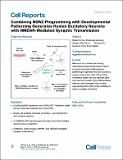| dc.contributor.author | Nehme, Ralda | |
| dc.contributor.author | Zuccaro, Emanuela | |
| dc.contributor.author | Ghosh, Sulagna Dia | |
| dc.contributor.author | Li, Chenchen | |
| dc.contributor.author | Sherwood, John L. | |
| dc.contributor.author | Pietilainen, Olli | |
| dc.contributor.author | Barrett, Lindy E. | |
| dc.contributor.author | Limone, Francesco | |
| dc.contributor.author | Worringer, Kathleen A. | |
| dc.contributor.author | Kommineni, Sravya | |
| dc.contributor.author | Zang, Ying | |
| dc.contributor.author | Cacchiarelli, Davide | |
| dc.contributor.author | Meissner, Alex | |
| dc.contributor.author | Adolfsson, Rolf | |
| dc.contributor.author | Haggarty, Stephen | |
| dc.contributor.author | Madison, Jon | |
| dc.contributor.author | Muller, Matthias | |
| dc.contributor.author | Arlotta, Paola | |
| dc.contributor.author | Fu, Zhanyan | |
| dc.contributor.author | Feng, Guoping | |
| dc.contributor.author | Eggan, Kevin | |
| dc.date.accessioned | 2018-09-07T17:23:53Z | |
| dc.date.available | 2018-09-07T17:23:53Z | |
| dc.date.issued | 2018-05 | |
| dc.date.submitted | 2018-03 | |
| dc.identifier.issn | 2211-1247 | |
| dc.identifier.uri | http://hdl.handle.net/1721.1/117674 | |
| dc.description.abstract | Transcription factor programming of pluripotent stem cells (PSCs) has emerged as an approach to generate human neurons for disease modeling. However, programming schemes produce a variety of cell types, and those neurons that are made often retain an immature phenotype, which limits their utility in modeling neuronal processes, including synaptic transmission. We report that combining NGN2 programming with SMAD and WNT inhibition generates human patterned induced neurons (hpiNs). Single-cell analyses showed that hpiN cultures contained cells along a developmental continuum, ranging from poorly differentiated neuronal progenitors to well-differentiated, excitatory glutamatergic neurons. The most differentiated neurons could be identified using a CAMK2A::GFP reporter gene and exhibited greater functionality, including NMDAR-mediated synaptic transmission. We conclude that utilizing single-cell and reporter gene approaches for selecting successfully programmed cells for study will greatly enhance the utility of hpiNs and other programmed neuronal populations in the modeling of nervous system disorders. Nehme et al. combine two strong neuralizing factors (transcription factor programming and small molecule patterning) to generate human excitatory neurons from stem cells. They further undertake single-cell and reporter gene approaches to select highly differentiated neurons with increased functionality, augmenting their utility in the modeling of nervous system disorders. | en_US |
| dc.publisher | Elsevier | en_US |
| dc.relation.isversionof | http://dx.doi.org/10.1016/j.celrep.2018.04.066 | en_US |
| dc.rights | Creative Commons Attribution 4.0 International License | en_US |
| dc.rights.uri | http://creativecommons.org/licenses/by/4.0/ | en_US |
| dc.source | Elsevier | en_US |
| dc.title | Combining NGN2 Programming with Developmental Patterning Generates Human Excitatory Neurons with NMDAR-Mediated Synaptic Transmission | en_US |
| dc.type | Article | en_US |
| dc.identifier.citation | Nehme, Ralda, et al. “Combining NGN2 Programming with Developmental Patterning Generates Human Excitatory Neurons with NMDAR-Mediated Synaptic Transmission.” Cell Reports, vol. 23, no. 8, May 2018, pp. 2509–23. © 2018 The Authors | en_US |
| dc.contributor.department | Massachusetts Institute of Technology. Department of Brain and Cognitive Sciences | en_US |
| dc.contributor.mitauthor | Feng, Guoping | |
| dc.relation.journal | Cell Reports | en_US |
| dc.eprint.version | Final published version | en_US |
| dc.type.uri | http://purl.org/eprint/type/JournalArticle | en_US |
| eprint.status | http://purl.org/eprint/status/PeerReviewed | en_US |
| dc.date.updated | 2018-08-30T12:48:34Z | |
| dspace.orderedauthors | Nehme, Ralda; Zuccaro, Emanuela; Ghosh, Sulagna Dia; Li, Chenchen; Sherwood, John L.; Pietilainen, Olli; Barrett, Lindy E.; Limone, Francesco; Worringer, Kathleen A.; Kommineni, Sravya; Zang, Ying; Cacchiarelli, Davide; Meissner, Alex; Adolfsson, Rolf; Haggarty, Stephen; Madison, Jon; Muller, Matthias; Arlotta, Paola; Fu, Zhanyan; Feng, Guoping; Eggan, Kevin | en_US |
| dspace.embargo.terms | N | en_US |
| dc.identifier.orcid | https://orcid.org/0000-0002-8021-277X | |
| mit.license | PUBLISHER_CC | en_US |
